One often unrealized impact of the Tar Sands development in Alberta Canada is the destruction of the Boreal Forest and the peatbogs or Muskeg. Eighteen months ago I participated in the Tar Sands Action blogathon. In the course of writing some tar sands diaries in 2011, I became interested on the impact to the Boreal Forests and Muskeg of the tar sands project . This diary is the result of that interest.
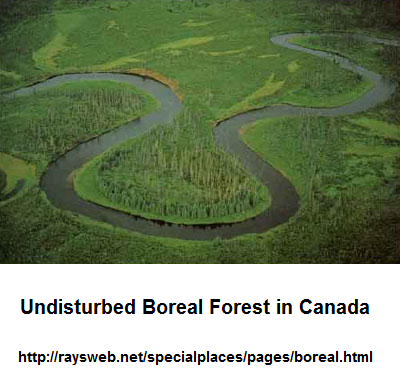
Peatbogs in Canada are known as Muskeg. Muskeg develops over thousands of years. Muskeg is formed by mostly decomposing sphagnum moss and other plants. Since decomposition doesnt occur during winter this process is slower than you might be used to seeing in a backyard compost pile, quite a bit slower. In permafrost, the layer of plant material my be thousands of years old.
To get to the tar sands oil companies have to remove the Muskeg, the clay and sand, typically removing 100 foot to 200 ft of material before exposing the tar sands. Once exposed to air, the Muskeg dries and decomposes, releasing Co2 and methane. The EPA tells us the Global Warming impact of methane is 20 times worse than Co2, pound for pound over a 100 year period.
My guess is that there may be 10 to 30 billion tons of GHG released by the destruction of the Muskeg over the planned 85 years of tar sands operations.
From the Pew Environmental Group, Canada's Boreal contains:
1) Half the world’s lakes larger than a square kilometer in
size.
2) 5 of the world’s 50 largest rivers.
3) Almost 200 million acres of surface water.
4) The world’s single largest remaining unpolluted fresh water body, Great Bear Lake.
5) Canada’s boreal contains 25 percent of the world’s wetlands and more surface water than any other continental-scale landscape.
Canada’s boreal waters also influence global climate. The wetlands and peatlands store an estimated 147 billion tonnes of carbon, more than 25 years worth of current man-made emissions, and the delta of the Mackenzie River alone stores 41 billion tonnes. The input of fresh water from boreal rivers to the Arctic and other northern seas is critical to forming sea ice, which cools the atmosphere and provides the basis for much of arctic marine biodiversity.
The
Natural Resources Defense Council has studied the impact of the tar sands development on Boreal birds. Of the 292 Breeding species of Boreal birds in Alberta, 65 are of "conservation concern".
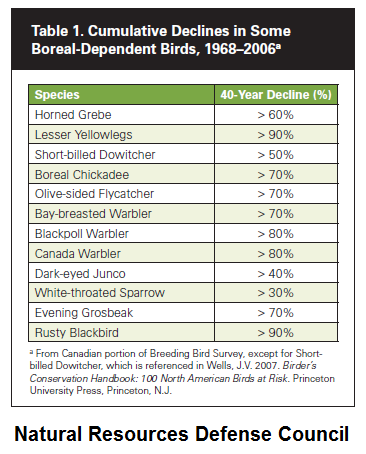
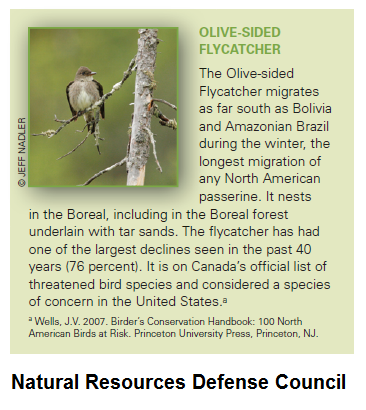
The loss of breeding habitat has already caused major declines in bird populations, if the tar sands development increases, the odds of extinctions will increase.
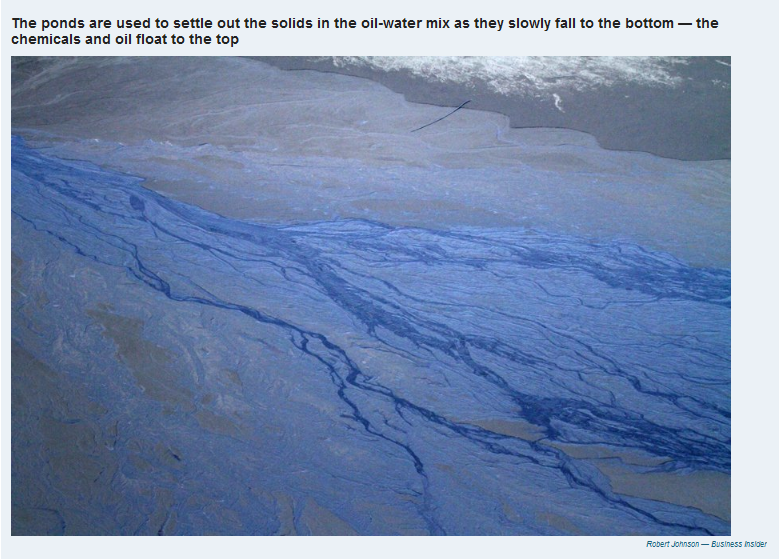
These chemicals and oil mean probable death for waterfowl landing on these "ponds". Heavily oiled birds sink, making accurate quantification difficult.
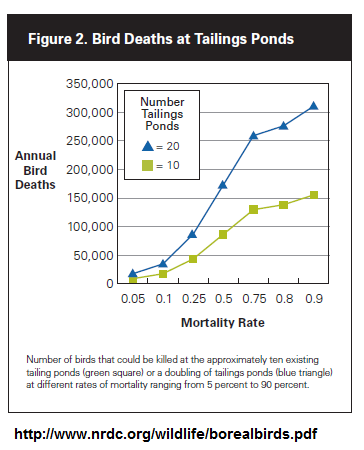

Caribou are in decline:
From Duke University:
Studies have also shown that caribou populations, which require large areas of connected forest to survive, have declined significantly in recent decades, due partly to tar sands extraction.
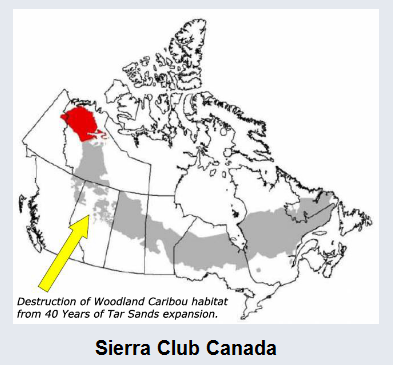
The Alberta Tar Sands have cut the Caribou range into 2 distinct ranges.
A bit of Family Feud humor.....Study says:
June 22, 2011 — Caribou have been dwindling in Alberta for several decades and some scientists believe they could be gone entirely in 70 years. In the area of the petroleum-rich Athabasca Oil Sands in the northern part of the Canadian province, some say they could disappear in as little as 30 years.
I want a
second opinion:
We found that 60% of the caribou winter diet consisted of lichen, which is extremely high in polysaccharides. This food source is particularly vital to pregnant caribou as it is high in glucose, which is the primary food source to the fetus. Fecal cortisol levels were strongly negatively correlated and thyroid hormone strongly positively correlated with the percent of lichen in that same fecal sample. Moreover, both elevated cortisol and diminished thyroid hormone resulted in suppression of progesterone in female caribou, compromising their pregnancies.
Since areas of high use human activities tend to be concentrated in lichen rich areas, our results suggest that moving activity centers away from lichen rich areas may be the best strategy for mitigating caribou declines in the oil sands.
While oil industry experts said the wolf was killing the Caribou, but only during the same period in which the tar sands have been developed. Before that the Wolves didnt kill Caribou.................
Plant diversity declines.....
University Of Alberta Researcher:
says there was a tipping point. When the amount of disturbed land in a study area began to exceed 50 per cent disturbed a threshold was reached and the researchers found fewer and fewer plant species.

For Summation here's a giant blockquote from the Pew Environmental Group
Many of the small mammals that provide the bulk of the food for predatory birds and mammals are found in highest densities in and near waterways and wetland habitats. These include the taiga vole, northern bog lemming, water shrew and cinereus shrew (Bowers et al. 2004
Beaver dams slow current, increasing lateral flow and enhancing nutrient deposit across broad areas. Presence of intact beaver dams increases habitat diversity as well as freshwater and adjacent terrestrial biodiversity. Insect biomass and abundance increases fivefold (Aznar and Desrochers 2008, Humphries and
Winemiller 2009) in areas with beaver dams, increasing overall abundance of fish and amphibians while also providing abundant resources for breeding waterfowl, osprey and other bird species such as woodpeckers, kingfishers and flycatchers (Wright et al. 2002). During drought conditions, beaver dams can help retain water bodies critical for retention of biological communities on the landscape (Hood and Bayley 2008).
That just goes to show you how amphibians, fish, mammals, birds are all interconnected to the Boreal Forest and the Muskeg. And Us. Once the infrastructure to fully develop the tar sands in place, stopping it will be next to impossible, oil will flow to super tanker loading facilities, the oil will be shipped to Asia and the western EU and used for transportation. And 85 years later the Albert tar sands will be depleted.
Building the next generation of energy infrastructure, with the coal and oil we have left is the number one priority.
"Forward On Climate" Blogathon: February 11 - February 15, 2013
Diary Schedule - All Times Pacific

IT IS TIME TO TAKE A STAND
Please join tens of thousands of Americans on the National Mall in Washington, DC on Feb. 17 from 12:00 pm-4:00 pm to urge President Barack Obama to take immediate action on Climate Change.
President Obama has now listed Climate Change as an important part of his second term agenda. Legislative proposals and debate will occur in Congress. President Obama can take executive action to move Forward on Climate now; he can reject the toxic Keystone XL tar sands pipeline. A recent study in Canada has linked tar sands with cancer, something First Nations groups have reported for years - with the result being increased cancer rates, deformed wildlife, and a variety of other negative impacts. President Obama can also direct the Environmental Protection Agency to set carbon standards for power plants.

Let your voice be heard.
SIGN UP TO SUPPORT THE "FORWARD ON CLIMATE" RALLY IN WASHINGTON, DC ON FEBRUARY 17TH
Our Daily Kos community organizers (Patriot Daily News Clearinghouse, citisven, boatsie, JekyllnHyde, rb137, and peregrine kate) coordinated this blogathon with Bill McKibben of 350.org to help spread the word.
8:00 am: Roger Fox Tar Sands: Muskeg Destruction is more than a methane GHG bomb.
11:00 am: Jeremy Bloom.
1:00 pm: Congressman Ed Markey, Democratic Candidate for 2013 United States Senate MA Special Election.
3:00 pm: FishOutofWater.
5:00 pm: Roger Fox Pipeline bottleneck may force slowdown of Tar Sands.
8:00 am: Roger Fox Tar Sands to consume all conventional natural gas reserves in Canada and Alaska.
11:00 am: Marty Cobenais (Ojibwe), U.S. Pipeline & Heavy Haul Resistance Organizer for Indigenous Environmental Network. Liveblogging with Tom Goldtooth (Dine' and Dakota), Executive Director of IEN and Oglala Sioux Tribal Vice President Tom Poor Bear.
1:00 pm: rb137.
3:00 pm: James Wells.
5:00 pm: jlms qkw.
8:00 am: Roger Fox Forward on Climate-EPA: Tar Sands-82% more GHG than conventional oil.
10:00 am: Phaedra Ellis-Lamkins, Chief Executive Officer of Green For All.
11:00 am: Agathena.
3:00 pm: DWG.
5:00 pm: JekyllnHyde.
Please remember to republish these diaries to your Daily Kos Groups. You can also follow all postings by clicking this link for the Climate Change SOS Blogathon Group. Then, click 'Follow' and that will make all postings show up in 'My Stream' of your Daily Kos page.
|
|
8:05 AM PT: Thanks to the 40 people who rec'ed this dairy by 11am.


